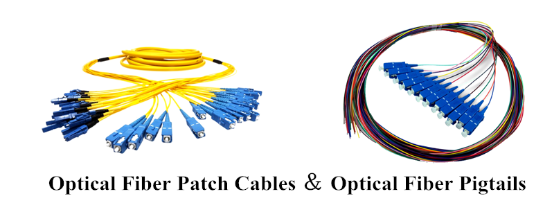Fiber Patch Cords vs. Fiber Pigtails
Fiber optic patch cord and fiber optic pigtail are two commonly used components in fiber optic networks. There are still a lot of confusion existing between them, because they have so much in common. Knowing both the similarities and the differences between them will help you make the best selection for your project. The article will mainly talk about their similarities and differences in both structures and applications.
Fiber patch cord, also referred to as fiber optic patch cable or fiber jumpers, is a short length of optical fiber cable with a connector on each end. Connector types on each side of the fiber patch cable can be different and they can also be the same. For example, an SC SC cable has one LC connector on each end, and an ST to LC fiber jumper has an ST connector on one end and an LC connector on the other end. Fiber optic pigtail is a piece of cable terminated with a fiber optic connector at only one end of the cable and leaves a length of exposed fiber at the other end, so that the connector side can link to the equipment and the other side can be melted with optical cable fibers or stripped and fusion spliced to a single fiber of a multi-fiber trunk. The following picture shows fiber optic patch cords and fiber optic pigtails.
Fiber optic patch cord and pigtail structurally have much in common. They are both available in single mode and multi-mode, and they can be made into simplex and duplex. Besides, both fiber patch cord and pigtail can terminate with many kinds of fiber optic connectors, including FC, SC, ST, LC, MTRJ, MPO, MU, SMA, FDDI, E2000, DIN4, and D4.
Functionally, both fiber optic patch cords and pigtails can provide interconnect and cross-connect of applications over installations in entrance facilities, data centers, and telecommunications rooms. They are available in OM4, OM3, OM2, OM1, or OS1/OS2 fiber types to meet the demands of Gigabit Ethernet, 10 Gigabit Ethernet and high speed Fibre Channel.

The major physical difference between fiber optic patch cable and pigtail is that fiber patch cord is a fixed length piece of cable with fiber connectors on each end while fiber pigtail has fiber connectors on only one end of the cable. Fiber optic patch cords can be cut into shorter lengths to make two pigtails. However, they have their respective application areas, too.
Fiber optic patch cords are commonly used to connect ports on fiber distribution frames. They support network applications in main, horizontal and equipment distribution areas and are available in optical fiber riser cable (OFNR), and low smoke zero halogen (LSZH) rated jacket materials to comply with local cabling ordinances. They also support high speed (10/40 Gbs) telecommunications. Fiber optic patch cords can be used in many areas, such as integrated optics, laser detection and display, and materials processing.
Fiber optic pigtails support fusion splice field termination applications. They should be installed where they will be protected and spliced, so they are usually used with fiber optic management equipment like optical distribution frame (ODF), splice closures and cross cabinets. Pigtails are found anywhere, but most commonly in optical assemblages or optical components. There are waterproof fiber optic pigtails used for outdoor applications, which is with thick poly ethylene (PE) jacket and big diameter.
FS.COM manufactures high quality fiber optic patch cords and pigtails using a variety of commercially available connectors and fibers. We provide various single mode and multi-mode fiber patch cords and fiber pigtails. These patch cords and pigtails offer low insertion losses, and excellent repeatability. And they can be customized to meet specific requirements.